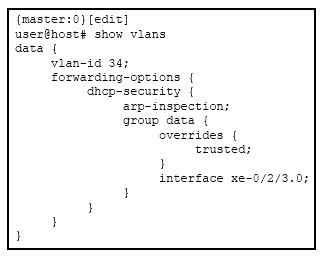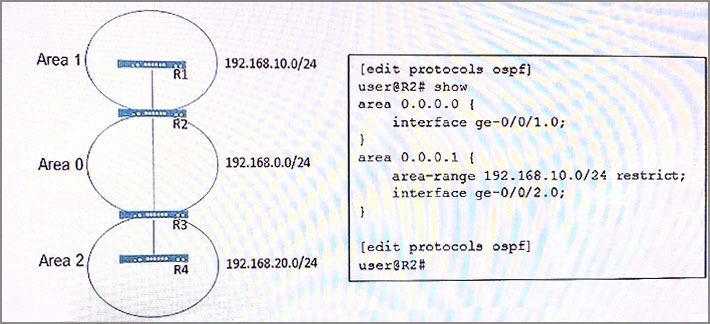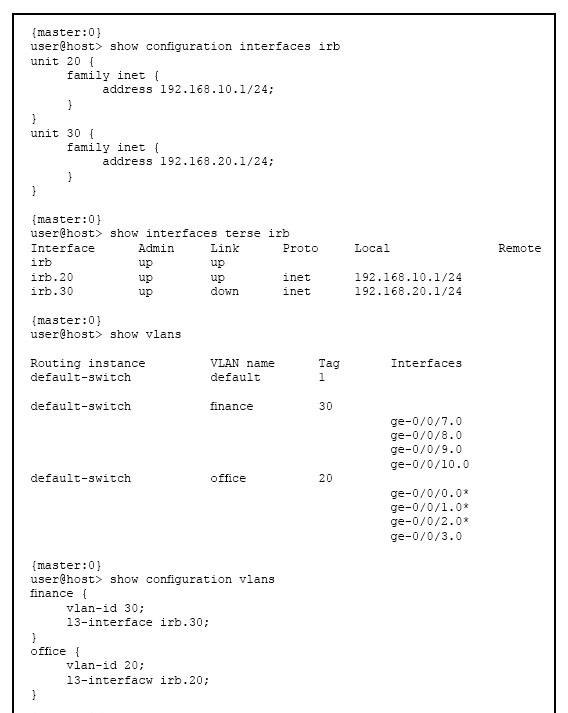Click the Exhibit button.

Referring to the exhibit, a packet tagged with vlan-id 34 arrives on interface xe-0/2/3.0 with a source MAC that does not match an entry in the DHCP snooping database.
In this scenario, which statement is correct?
Click the Exhibit button.

Referring to the exhibit, a packet tagged with vlan-id 34 arrives on interface xe-0/2/3.0 with a source MAC that does not match an entry in the DHCP snooping database.
In this scenario, which statement is correct?
In this scenario, the packet is forwarded and no error message is logged. The interface xe-0/2/3.0 is marked as trusted in the configuration. DHCP snooping typically inspects packets on untrusted interfaces. Since the packet arrives on a trusted interface, it will be forwarded without error.
Which three statements are true regarding not-so-stubby areas (NSSAs)? (Choose three.)
You cannot configure an area as both an NSSA and a stub area. NSSA imports external routes as Type 7 LSAs, which are converted to Type 5 LSAs by the ABR when advertised to other areas. In an NSSA, external routes are not exported as Type 3 LSAs; these are used for intra-area routes. Additionally, NSSAs do require an ABR to connect to other OSPF areas.
Click the Exhibit button.

Referring to the exhibit, which effect does the configuration on R2 have on OSPF routing in the network?
The configuration shown indicates the use of OSPF routing with specific commands on R2. The command 'area 0.0.0.1 { area-range 192.168.10.0/24 restrict; }' instructs R2 to summarize the range 192.168.10.0/24 and restrict its advertisement. This means that the 192.168.10.0/24 route will not be advertised to other areas, specifically Area 1 in this context. Therefore, the 192.168.10.0/24 route will not be advertised to Area 1.
What are two terminating actions of a Layer 2 firewall filter? (Choose two.)
In the context of a Layer 2 firewall filter, the two terminating actions are 'reject' and 'discard.' These actions determine the fate of packets that match the filter criteria by either specifically denying them (reject) or simply dropping them (discard). 'Accept' is not typically considered a terminating action in firewall filters and serves a different function, and 'log' is used for recording information about the packets rather than terminating their flow.
Click the Exhibit button.

You are performing network tests and notice that the Layer 3 interface in the Finance VLAN on an EX Series switch is not responding to pings. You review the device status from the console.
What is causing the problem, as shown in the exhibit?
The problem is that there are no active physical ports in the Finance VLAN. According to the exhibit under 'show vlans,' the physical interfaces in the Finance VLAN are all listed under 'default-switch' and their status is not indicated in the 'show interfaces terse' output. For an IRB interface to be fully operational (up/up), there must be active physical ports in the associated VLAN. The exhibit shows that irb.30 is administratively up but the protocol is down, indicating no active physical participants in the Finance VLAN.